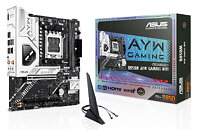
MSI Intros the MPG B850I EDGE TI WIFI Mini-ITX Motherboards
MSI listed the MPG B850I EDGE TI WIFI, a Mini-ITX form-format AMD AM5 socket motherboard built around AMD's B850 chipset with support for the latest Ryzen CPU series. The board features an 8+2+1 phase digital VRM with 90 A SPS DrMOS power stages, powered through a single 8-pin EPS connector. It uses a 10-layer PCB with 2oz copper for enhanced conductivity and thermal performance. The motherboard supports DDR5 memory up to 8200 MT/s in a dual-slot, single DIMM per channel configuration. Storage connectivity includes a front-mounted PCIe 5.0×4 M.2 slot with active cooling fan connected directly to the CPU, plus a rear PCIe 4.0×4 M.2 slot through the chipset and two SATA III ports. A single PCIe 5.0×16 slot provides GPU connectivity via CPU lanes.
Networking capabilities include 5 GbE wired connectivity through a Realtek RTK8126 controller and Wi-Fi 7 with 320 MHz channels supporting up to 5.8 Gbps, alongside Bluetooth 5.4. Audio processing uses the Realtek ALC4080 codec. The I/O configuration provides USB-C connectivity at 20 Gbps on the rear panel and 10 Gbps via internal header, multiple USB-A ports ranging from 480 Mbps to 10 Gbps speeds, HDMI 2.1 FRL video output, S/PDIF digital audio, and dual antenna connectors for wireless connectivity. The active cooling fan on the primary M.2 slot addresses thermal management for high-performance PCIe 5.0 SSDs while maintaining the compact Mini-ITX form factor.
Networking capabilities include 5 GbE wired connectivity through a Realtek RTK8126 controller and Wi-Fi 7 with 320 MHz channels supporting up to 5.8 Gbps, alongside Bluetooth 5.4. Audio processing uses the Realtek ALC4080 codec. The I/O configuration provides USB-C connectivity at 20 Gbps on the rear panel and 10 Gbps via internal header, multiple USB-A ports ranging from 480 Mbps to 10 Gbps speeds, HDMI 2.1 FRL video output, S/PDIF digital audio, and dual antenna connectors for wireless connectivity. The active cooling fan on the primary M.2 slot addresses thermal management for high-performance PCIe 5.0 SSDs while maintaining the compact Mini-ITX form factor.

























































































